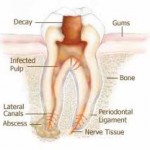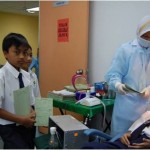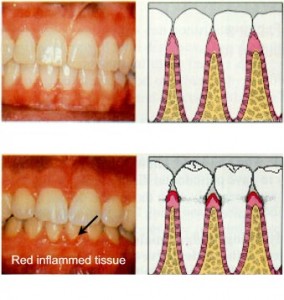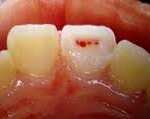In Malaysia, we are blessed for we are given free dental services in the primary and secondary schools nationwide by the Malaysian Dental Association (MDA). Due to the expensive charges from private dentists, and the long waiting line in government dental clinics, many parents are very reluctant to bring their children to see the dentist. Some of parents could not even afford it. Most of the parents have the concept that, milk teeth (the baby’s first set of teeth) are going to fall out sooner or later, so they are not important at all. This is not true, as poorly taken care of milk teeth will lead to many problems in the future, and in some circumstances, will negatively affect the permanent teeth. Continue reading
Yearly Archives: 2010
Symptoms indicating when you need a Root Canal Treatment
What is Root Canal Treatment (RCT)?
 Root canal treatment is the removal of inflamed and/or infected dental pulp tissue from the root canal system, shaping and filling the root canals of a diseased tooth. The key factor in the development of pulpal inflammation and breakdown of the supporting tissues of the tooth (periradicular tissues) is the presence of bacteria. These endodontal infections (infections within teeth) are usually characterized by loss of integrity of the crown, invasion by bacteria, and destruction of enamel, dentine, and eventual pulpal involvement. Dental caries, trauma, tooth surface loss, and microleakage around tooth fillings can lead to endodontal infection. In situations where there has been periradicular breakdown, root canal treatment will result in the return of the health of the periradicular tissues. Ultimately, root canal treatment preserves teeth as functional units within the dental arch. Continue reading
Root canal treatment is the removal of inflamed and/or infected dental pulp tissue from the root canal system, shaping and filling the root canals of a diseased tooth. The key factor in the development of pulpal inflammation and breakdown of the supporting tissues of the tooth (periradicular tissues) is the presence of bacteria. These endodontal infections (infections within teeth) are usually characterized by loss of integrity of the crown, invasion by bacteria, and destruction of enamel, dentine, and eventual pulpal involvement. Dental caries, trauma, tooth surface loss, and microleakage around tooth fillings can lead to endodontal infection. In situations where there has been periradicular breakdown, root canal treatment will result in the return of the health of the periradicular tissues. Ultimately, root canal treatment preserves teeth as functional units within the dental arch. Continue reading
How to Recognize Gingivitis Symptoms
A major cause of tooth loss in adults is periodontal disease. The term gum disease or periodontal disease includes both gingivitis and periodontitis, and it affects the periodontium which consists of the tissue that surrounds and supports the teeth. However with early detection and treatment of the disease, it is now possible for most people to keep their teeth for a lifetime. Continue reading
How to recognize the side effects of Root Canal Treatments

symptoms of failed root canal treatment
After a lengthy root canal treatment (RCT) Â procedure, most do ponder “How would I know whether it is a good job done?” Drifting on, our thoughts eventually go to whether the treatment has really saved our tooth. Is a root filling all you need to solve your woes? Continue reading
Invisalign-Problems arising from treatment
 Invisalign is a series of clear,transparent, removable devices that are used to align teeth to the desirable position. It is used as an alternative to metal dental braces due to its cosmetic value. This cutting edge dental treatment is available in the U.S and a few other countries worldwide. A full set of treatment usually includes 20 to 30 aligners per arch, though the number varies for each individual. Each aligner is designed with exact calculations according to your teeth position to gradually shift your teeth into place. The invisalign system is custom made and each retainer is switched every two weeks. Continue reading
Invisalign is a series of clear,transparent, removable devices that are used to align teeth to the desirable position. It is used as an alternative to metal dental braces due to its cosmetic value. This cutting edge dental treatment is available in the U.S and a few other countries worldwide. A full set of treatment usually includes 20 to 30 aligners per arch, though the number varies for each individual. Each aligner is designed with exact calculations according to your teeth position to gradually shift your teeth into place. The invisalign system is custom made and each retainer is switched every two weeks. Continue reading
How to Temporarily Replace a Tooth Filling
You are starving. It’s that really annoying sensation down there that drives us all on an eating spree, devouring anything edible. However in your haste of consumption you fail to notice a small but hard piece of bone fragment in your freshly prepared chicken sandwich. You chomp into it. Very hard. There is a moment of silence as a sharp crack vibrates your skull. You spit out what remains of your meal and discover two hard objects; chicken bone and a piece of tooth filling. It’s a Sunday, your family dentist is closed for the weekend. What do you do?
The very first thing that you should do is evaluate the site of fracture. Take notice of any or a combination of:
1.      Pain
2.      Sensitivity ( to air, cold or hot fluids )
3.      Extent of the fracture
4.      Bleeding
How to Treat a Baby Teething Rash
A baby starts teething around 5-6 months old, when the lower middle tooth (also known as incisor) starts coming out. As the tooth keeps pushing against the gums, the baby will feel very irritated, and will soon start waking up in the middle of the night, crying. Other signs of the baby teething are like biting everything within their reach, and drooling a lot. It is due to this excessive drooling, the saliva overflows and accumulates within the baby’s skin folds, soaking the skin. Thus, babies get what is known as teething or drooling rash. Continue reading
Complications of Root Canal Treatment
What is root canal therapy?
Root canal therapy is a series of treatment done to the pulp to remove the source of infection in the pulp and prevent further infection to the disinfected pulp, thus maintaining its health and vitality.
Root canal treatment, on the other hand, is carried out if the pulp is seriously infected, and when tests reveal that the pulp is irreversibly damaged or dead. Root canal treatment involves removal of the damaged or dead pulp content and sealing the root canal space with a suitable material eg. gutta percha. Continue reading
How to stop bone loss in teeth naturally
What does it mean by dental bone loss?

Bone loss
For our convenience, the term bone loss is differentiated to two types in our mouth. The loss of bone specifically involving jaw (alveolar) bone area but are not involving teeth is referred as dental bone loss. Meanwhile, teeth bone loss means loss of roots of teeth or the jaw bone surrounding teeth. At times, it is possible to have both bone loss happening simultaneously. Continue reading
The Advantages of Dental Implants
There are several ways of replacing a missing tooth. The most common ways (if only one tooth is missing), are by bridges or implants. If a few teeth are missing, dentures, bridges, or implants can be used. Implants are screws that are planted into the gums, with a tooth like cap sitting on the screw, so that implants look exactly (depending on the refinement of the work) like a real tooth. Continue reading




